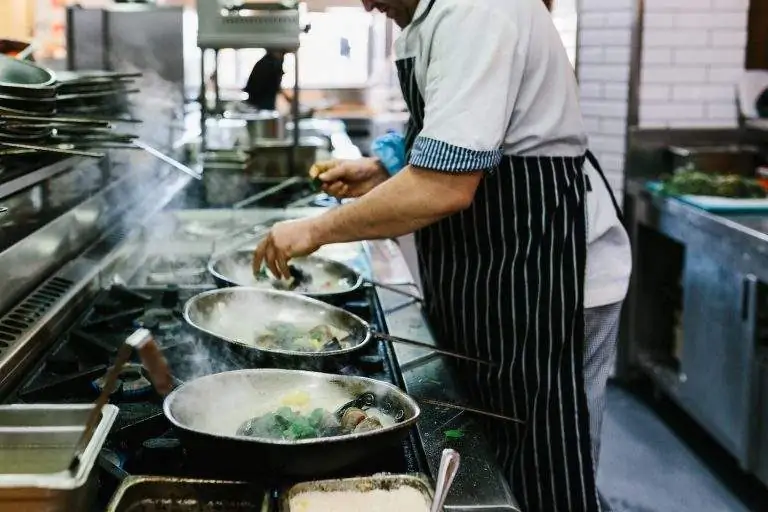Running a successful restaurant involves more than just serving great food. It requires a keen understanding of your finances, particularly your profit margins. After all, profit is how much your restaurant is making on a day-to-day basis and provides an indication of how well you’re doing.
It’s an all-important metric that influences everything from menu pricing to operational decisions and beyond. With that in mind, this guide has all you need to know about profit margins, including a handy restaurant profit margin calculator to determine your own profits and get a read on your restaurant’s finances.
Quick links
- What is a restaurant profit margin?
- Calculating your restaurant’s profit margin
- Restaurant profit margin calculator
- Why you need to track profit margins over time
- Understanding your restaurant’s costs
- How to improve your restaurant’s profit margin
- Common profit margin pitfalls to avoid
What is a restaurant profit margin?
A profit margin is the percentage of revenue that becomes profit after accounting for all expenses. It’s helpful for understanding your restaurant profitability, and there are two main types you need to consider:
- Gross profit margin measures profit from food and beverage sales before accounting for operating expenses. Calculate it by subtracting the cost of goods sold (COGS) from total revenue, then dividing by total revenue.
- Net profit margin is your bottom line—what’s left after paying for everything, including food costs, labor, rent, and other operating expenses. Calculate it by dividing net income by total revenue.
Both are important, but net profit margin provides the clearest picture of overall financial performance because it reflects your restaurant’s ability to generate profit after all expenses—including taxes and interest—have been deducted.
What is the average profit margin for a restaurant?
Do, how profitable are restaurants when it comes to averages? The average profit margin for restaurants vary depending on factors like restaurant type and location. Recent data suggests average restaurant profit margins fall anywhere between 3-5% for full-service restaurants and 6-9% for quick-service establishments. Many successful restaurants operate with higher margins however.
Calculating your restaurant’s profit margin
To calculate your restaurant’s profit margin, you’ll need your total revenue and expenses for a given period (usually a month or year).
To find your profit margin, follow these steps:
- Calculate your gross profit: Subtract the cost of ingredients from your total sales.
- Figure out your net profit: Take your gross profit and subtract all other expenses (like rent, labor, and utilities).
- Determine your profit margin: Divide your net profit by your total sales, then multiply by 100 to get a percentage.
For example, if you made $10,000 in sales, spent $3,000 on ingredients, and had $6,000 in other expenses:
- Gross profit: $10,000 minus $3,000 equals $7,000
- Net profit: $7,000 minus $6,000 equals $1,000
- Profit margin: ($1,000 divided by $10,000) times 100 equals 10%
In this case, your restaurant’s profit margin would be 10%.
Restaurant profit margin calculator
Why don’t you try it for yourself? Use our profit margins calculator to see how much profit your restaurant turns over.
Why you need to track restaurant profit margins over time
It’s one thing to know your profit margin at a specific point in time, but you should also track it over time to get a better understanding of how well your restaurant is doing. It will also help you:
- Identify trends: Are your margins improving or declining? Is there a seasonal pattern?
- Measure the impact of changes: Did that new menu item boost your profits? Has your recent cost-cutting measure paid off?
- Set realistic goals: Understanding your historical performance helps you set achievable targets.
- Make data-driven decisions: A clear picture of your financial performance over time enables more informed decisions about aspects like menu changes and potential expansion plans.
Understanding your restaurant’s costs
Knowing the makeup of your restaurant’s cost gives you a clearer picture—and understanding—of what you’re spending and the amount you actually take home.
Here’s a breakdown of the average restaurant costs.
- Cost of goods sold (COGS) includes ingredient and beverage costs. Many restaurants aim to keep COGS around 28-35% of total sales.
- Labor costs cover wages, benefits, and payroll taxes. Try to keep labor costs between 25-35% of total sales.
- Overhead costs are fixed costs including rent, utilities, equipment leases, and insurance. They typically account for about 10-15% of total sales.
- Marketing and advertising are fundamental for growth, but restaurants tend to keep these costs to about 3-6% of total sales.
How to improve your restaurant’s profit margin
Even incremental changes can have an impact on increasing your profit margins so your restaurant earns more. Consider the following to improve your profit margins:
Menu engineering
Your menu should be one of the first places you look for improving profitability. After all, it’s a key driver in getting diners into your restaurant. Analyze which items are most popular and profitable, then place and price dishes to encourage higher-margin sales.
Control food costs
Small changes in food costs can significantly impact the revenue you bring in. Even minor adjustments to ingredient costs or portion sizes have the potential to lead to substantial savings over time, directly affecting your bottom line.
Here are some strategies to keep your food costs in check:
- Regularly update recipes and train staff to follow them precisely and avoid over portioning. Consistency in portion sizes shows that you’re not giving away extra food unnecessarily. Create standardized recipes with exact measurements and train your kitchen staff to use the likes of portion scales or scoops to maintain accuracy.
- Shop around for the best ingredient prices without sacrificing quality. Building relationships with multiple suppliers helps you compare prices and negotiate better deals. Consider seasonal ingredients to take advantage of lower costs when certain items are plentiful.
- Use inventory management software to track usage and reduce waste. These systems can help identify which ingredients are being overused or underused, spot potential theft, and forecast needs more accurately. A data-driven approach can significantly reduce food waste and overordering.
- Consider joining a group purchasing organization (GPO) to make the most of bulk buying power. GPOs negotiate discounts with suppliers on behalf of their members, allowing smaller restaurants to access pricing typically reserved for large chains.
Implementing these strategies helps you maintain tight control over your food costs without compromising on the quality of your dishes. Even small savings on individual ingredients can add up to substantial improvements in your overall profit margin.
Optimize labor costs
Staff costs often represent the largest slice of a restaurant’s expense pie. Striking the right balance between strong coverage and cost efficiency is one of the hardest—but most important—balancing acts.
- Use modern scheduling tools to match staffing levels with expected demand. These systems help you avoid having too many hands on deck during quieter times, while showing that you’re well-prepared for rush periods.
- Consider investing in versatility by teaching your team members multiple skills. A server who can also mix drinks or a line cook who can handle prep work gives you more flexibility in your scheduling.
- Don’t forget about your point-of-sale system (POS). It will help you gain insights into staff performance. Many modern POS solutions offer detailed restaurant analytics on sales per employee, average ticket sizes, and other productivity metrics. Use this data to identify top performers, areas for improvement, and opportunities for additional training.
- Consider implementing a tip pooling system to encourage teamwork and have fair compensation across different roles. This can lead to better overall service and increased job satisfaction.
- Explore creative scheduling options like split shifts or part-time positions to cover peak hours without overstaffing during slower periods.
Fine-tuning your approach to staff management can significantly impact labor costs while maintaining high-quality service and a positive work environment. Your team is your most valuable asset—the goal is to optimize their time and skills rather than cut corners on quality or morale.
Do that, and you’ve got a profitable setup that delights guests and keeps your restaurant running like a well-oiled machine.
Reduce overhead
While some fixed costs are unavoidable, there’s often room to improve your overhead expenses:
- Regularly assess your contracts with suppliers and service providers. Don’t hesitate to shop around or ask for better rates, especially if you’ve been a loyal customer. Sometimes, simply expressing interest in competitive offers can lead to improved terms.
- Consider upgrading to energy-efficient equipment and lighting. While there may be upfront costs, the long-term savings on utility bills can be substantial. Look into local energy-saving programs that might offer rebates or incentives.
- If your restaurant has quiet periods or unused areas, think creatively about how to monetize that space. Could you host cooking classes, private events, or even sublet to a complementary business during off-hours?
- Review any recurring payments for software, services, or memberships. Cancel what you’re not using and look for bundle deals on necessary services to potentially lower costs.
With a proactive approach to managing these expenses, you can free up resources to reinvest in your business or drive more revenue.
Increase sales
Increasing your overall revenue can have a significant impact on your profit margin. From training staff to rewarding regular guests, there are many actions you can take to boost sales.
- Train your staff to recommend complementary items or upgrades that enhance the dining experience. For example, suggesting a perfect wine pairing or highlighting a premium side dish can increase check averages while adding value for guests.
- Develop special offers to attract customers during traditionally slower periods. This could include early bird discounts, weekday lunch deals, or happy hour promotions. Make sure these offers are still profitable while providing value to your guests.
- Target diners during off-peak times to drive bookings when you need them most. With effective marketing campaigns, you can get your restaurant in front of the right diners at the right time, resulting in more people seated at your restaurant. Pay only for guests who dine with you—never for impressions, clicks, leads, or calls—so the ROI is always there.
- Use your customer data to create targeted campaigns that hit the right spots with specific segments of your audience. This could involve personalized email offers based on past orders or social media ads tailored to local events and preferences.
- Encourage repeat visits by rewarding your regular customers. A well-designed loyalty program can increase visit frequency and average spend while fostering a sense of connection with your restaurant.
- Consider adding catering services, meal kits, or branded merchandise to create additional income sources that complement your core restaurant business.
Focusing on these sales-boosting techniques can increase your overall revenue, potentially leading to improved profit margins even without significant cost reductions.
Use technology
By now, saying “use technology” is a bit like saying “do marketing.” But it shouldn’t be understated how the right technology can improve your profit margin while making you and your team’s lives much easier. Consider these strategies:
- Implement a reservation system, such as OpenTable, to manage your dining room more effectively with the aim of reducing no-shows, maximizing capacity, and providing valuable data on your guests’ preferences and dining habits.
- Tap into the growing demand for convenience by offering online ordering and delivery options. Doing so can open up new revenue streams without significantly increasing your overhead costs.
- Use analytics tools to gain insights into your business performance. Data can help you identify popular dishes, set the best pricing, and understand peak operating hours. You can make data-driven decisions about your menu and operations.
- Consider implementing tableside ordering systems or self-service kiosks to improve order accuracy and speed up service if your restaurant’s vibe calls for it. These technologies can also free up your staff to focus on providing exceptional hospitality.
- Look into software solutions for inventory management, employee scheduling, and accounting. Automating these processes can save time, reduce errors, and provide real-time insights into your business performance.
- Embrace AI. Tools like ChatGPT can streamline operations by automating routine tasks and providing support in areas such as menu creation, customer interaction, and data analysis.
Whether you’re adopting new AI trends, understanding data or using a restaurant reservation management system like OpenTable, incorporating different aspects of technology into your operations helps improve efficiency while also enhancing the guest experience.
Common profit margin pitfalls to avoid
Even seasoned restaurateurs can fall into traps that eat into profit margins. It’s important to stay alert to common mistakes so you don’t end up overspending:
Neglecting inventory management
Poor inventory practices silently kill profits. Without proper tracking, you risk over-ordering items that go to waste or running out of key ingredients during busy service times. Implement an inventory system to track usage, reduce waste, and prevent theft. Regular inventory checks and clear par levels can make a difference in controlling food costs.
Underpricing menu items
While it’s important to stay competitive, don’t sell yourself short. Review your menu pricing regularly and measure it against your costs and the local market. Consider the value of your unique offerings and atmosphere. Sometimes, a slight price increase can boost profits without putting off customers. Use menu engineering techniques to highlight your most profitable items.
Ignoring customer feedback
Your guests are a goldmine of information. Pay attention to their comments, both in-person and online. Are there consistent complaints about portion sizes, service speed, or dish quality? Address these and similar issues if so. Positive feedback can also guide you towards your most popular offerings, helping you refine your menu and marketing strategies.
Failing to adapt
The restaurant industry evolves quickly, whether it’s changing food trends, technology, or customer expectations. Stay informed about industry developments and be ready to adjust your approach. This might mean embracing new reservation technologies, exploring sustainable ingredients, or adapting your service model during challenging times.
Overlooking small expenses
It’s easy to focus on big-ticket items like your lease and ignore the small costs, but these can quickly add up. Keep a close eye on all of your expenses, from cleaning supplies to garnishes. Regular audits of your spending might reveal surprising areas for cost-cutting. Consider bulk purchasing for frequently used items, but always balance this against storage space and perishability.
Ineffective staff training
Poorly trained staff, a bad handbook, or the wrong hires can lead to mistakes, waste, and dissatisfied customers. Invest time in thorough training programs that cover not just job basics, but also upselling techniques, efficient workflows, and exceptional customer service. Well-trained staff can boost your bottom line through increased sales and repeat business.
Summary: sustainable profitability
Being proactive in these areas protects your profit margins and sets your restaurant up for long-term success. Running a profitable restaurant demands consistently smart decisions across all aspects of your business. With a clearer picture of your restaurant’s health, you can make smarter choices for long-term success.
OpenTable offers a restaurant guest experience platform designed to provide you with the necessary tools and data to optimize profit margins.




